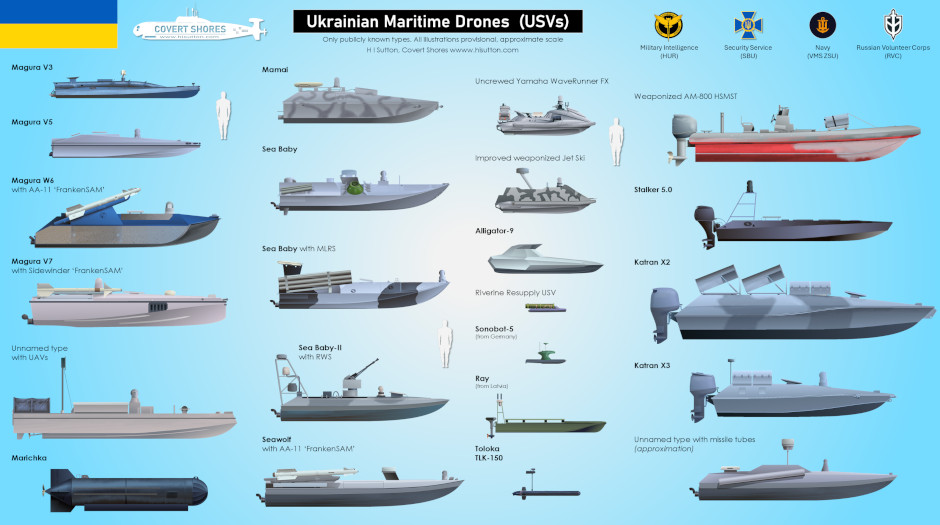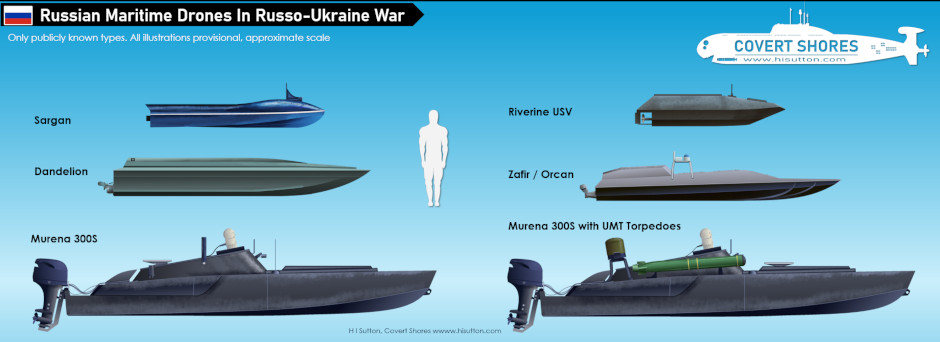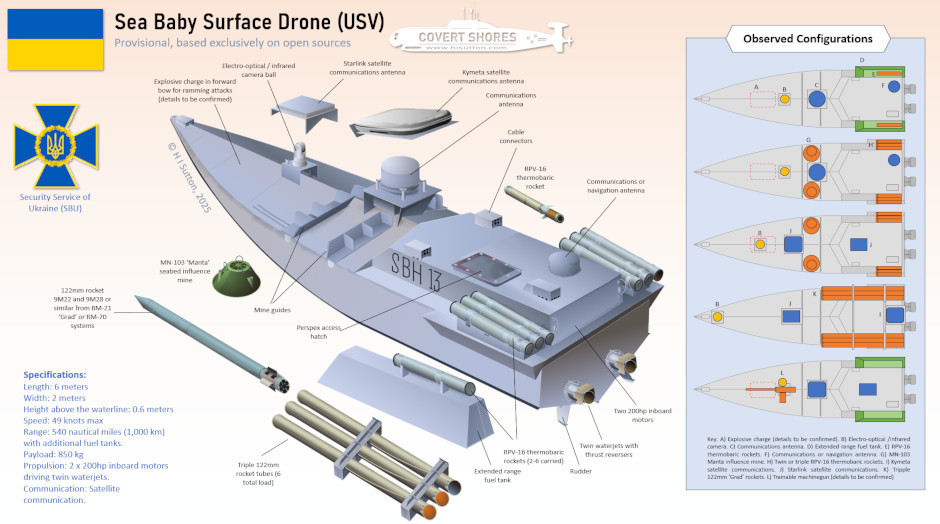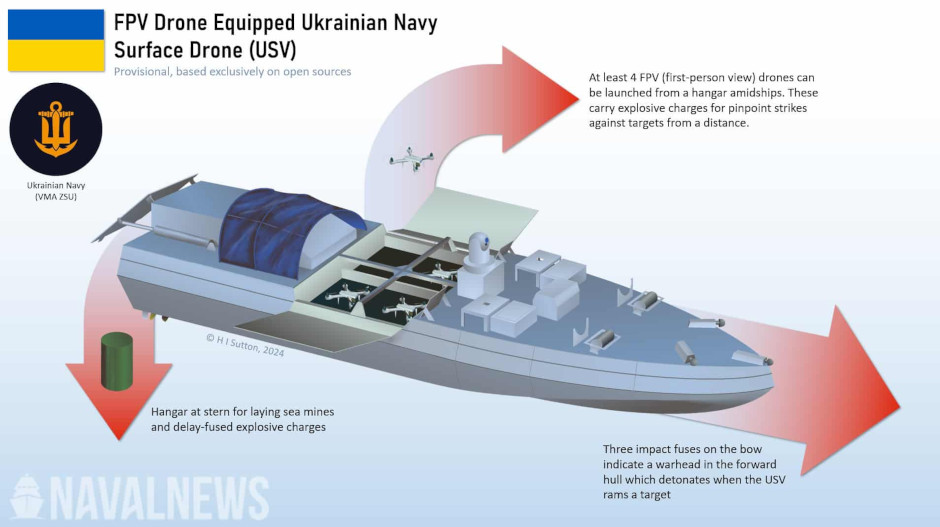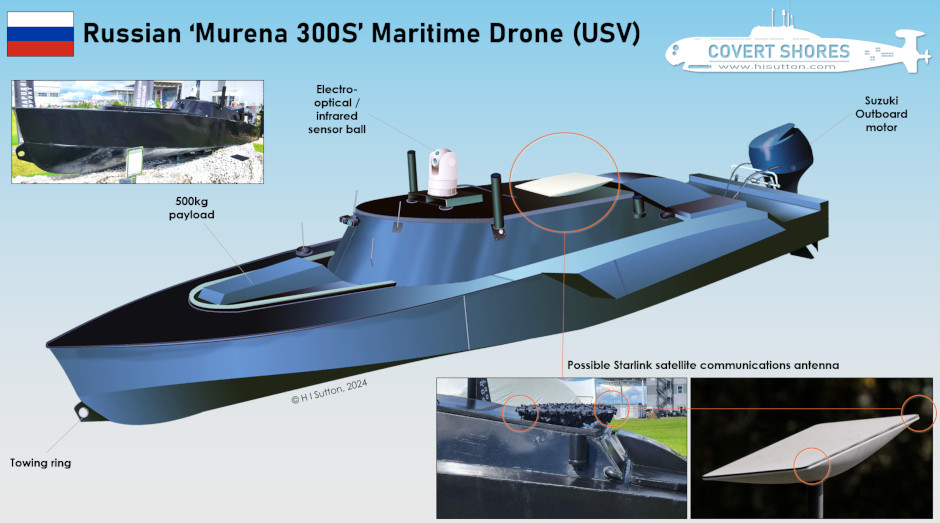Overview Of Maritime Drones (USVs) Of The Russo-Ukrainian War, 2022-24
UPDATED
CLICK to Enlarge.
CLICK to Enlarge.
Overview Of Maritime Drones (USVs) Of The Russo-Ukrainian War, 2022-24

 Following Russia’s full-scale invasion in 2022, Ukraine swiftly developed a potent uncrewed naval force. Utilizing explosive-equipped uncrewed surface vessels (USVs), Ukraine has successfully inflicted significant damage on the Russian Navy. These pose such a formidable threat that the Russian fleet into a state of inactivity at port. This grants Ukraine a level of sea denial that was scarcely conceivable just a few years ago.
Following Russia’s full-scale invasion in 2022, Ukraine swiftly developed a potent uncrewed naval force. Utilizing explosive-equipped uncrewed surface vessels (USVs), Ukraine has successfully inflicted significant damage on the Russian Navy. These pose such a formidable threat that the Russian fleet into a state of inactivity at port. This grants Ukraine a level of sea denial that was scarcely conceivable just a few years ago.
The cornerstone of this achievement, in my opinion, lies primarily in the implementation of uncrewed platforms. This has allowed operations which would not have been viable with crewed vessels. Uncrewed vessels can be smaller, and expendable.
Ukraine’s uncrewed vessel revolution has in turn only been possible because of real-time two-way satellite communications. There have been uncrewed platforms before, but high bandwidth communications allows human-in-the-loop control. This enables faster deployment and rapid adaption to evolving targets and missions. Starlink serves as the primary provider of satellite communications, although Kymeta is also utilized. Automation will improve, likely making this human-in-loop command less necessary, but that is some way off.
We have also seen some development of semi-submerged or fully submerged versions. These fall under the UUV or AUV (uncrewed underwater vehicle, or autonomous underwater vehicle) category.
All current designs are characterized as being relatively small, much smaller than if humans had to be carried. This has many advantages.
There are, for sure, more types under development. This visualization only includes publicly revealed types.
Magura V3
 The first of Ukraine’s USVs to be revealed, the ‘Magura V3’ were used in September 2023 and the dramatic raid on Sevastopol on October 29 2022. These USVs were used, together with UAVs, to attack the Russian Navy in port. Two warships, the frigate Admiral Makarov and the minesweeper Ivan Golubets were damaged.
The first of Ukraine’s USVs to be revealed, the ‘Magura V3’ were used in September 2023 and the dramatic raid on Sevastopol on October 29 2022. These USVs were used, together with UAVs, to attack the Russian Navy in port. Two warships, the frigate Admiral Makarov and the minesweeper Ivan Golubets were damaged.
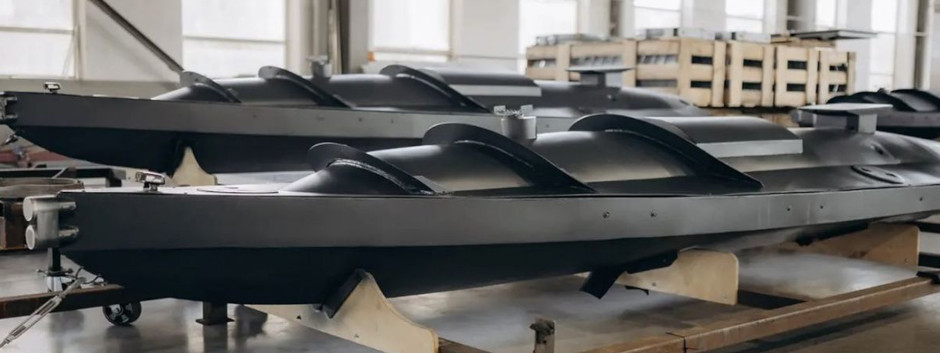
Magura V3 specifications
Length: 5.5 meters
Full weight: up to 1,000 kg
Range: up to 430 nautical miles (800 km)
Autonomy: up to 60 hours
Combat load: up to 200 kg
Max speed: 43 knots (80 km/h)
Navigation methods: automatic GNSS, inertial, visual
Video transmission: up to 3 HD video streams
Crypto protection: 256-bit encryption
Magura V5
 The Magura V5 is the main type known to be in service with the GUR (Ukrainian Defence Intelligence). Images were made public until May 24 2023 when some attacked the Russian Navy intelligence ship Ivan Khurs. This was significant because it occurred far south of Crimea, showing the USV’s impressive range. The attack was unsuccessful, as was another on intelligence ship, Priazovye, on June 11. The circumstances of these attacks are unclear and it appears that some of the USVs may have been inoperable before being engaged by Russian guns. The new version is associated with the designation Magura V5. Magura’s have since been involved in multiple missions and sunk several high-value Russian ships.
The Magura V5 is the main type known to be in service with the GUR (Ukrainian Defence Intelligence). Images were made public until May 24 2023 when some attacked the Russian Navy intelligence ship Ivan Khurs. This was significant because it occurred far south of Crimea, showing the USV’s impressive range. The attack was unsuccessful, as was another on intelligence ship, Priazovye, on June 11. The circumstances of these attacks are unclear and it appears that some of the USVs may have been inoperable before being engaged by Russian guns. The new version is associated with the designation Magura V5. Magura’s have since been involved in multiple missions and sunk several high-value Russian ships.

Magura V5 specifications:
Length: 5.5 meters
Width: 1.5 meters
Height above the waterline: 0.5 meters
Speed: 22 knots cruising, 42 knots max
Range: 450 nautical miles (approximately 833 km)
Payload: 320 kg
Communication: mesh radio with an aerial repeater or satellite communication.
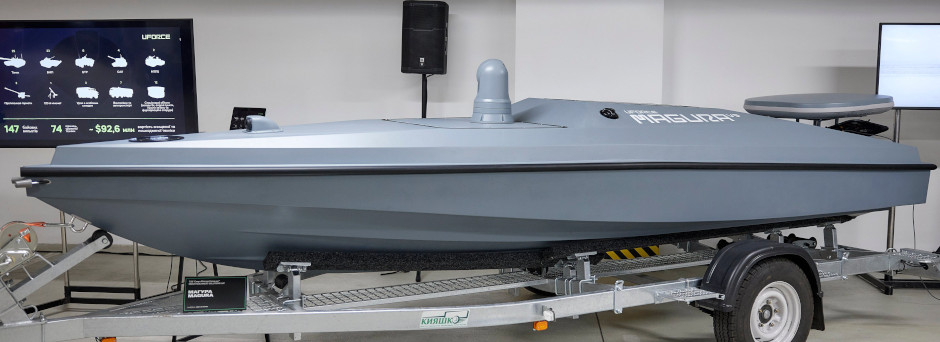
Magura V5 maritime drone via SpetsTechnoExport / Uprom
Magura W6 with’FrankenSAM’
 Ukrainian uncrewed surface vessel (USV) armed with an improvised air-defense system with the ‘Sea Dragon’ stystem consisting of two AA-11 ARCHER (R-73) missiles. Produced by Magura and used by GUR. The ‘W’ refers to a whaler hull.
Ukrainian uncrewed surface vessel (USV) armed with an improvised air-defense system with the ‘Sea Dragon’ stystem consisting of two AA-11 ARCHER (R-73) missiles. Produced by Magura and used by GUR. The ‘W’ refers to a whaler hull.
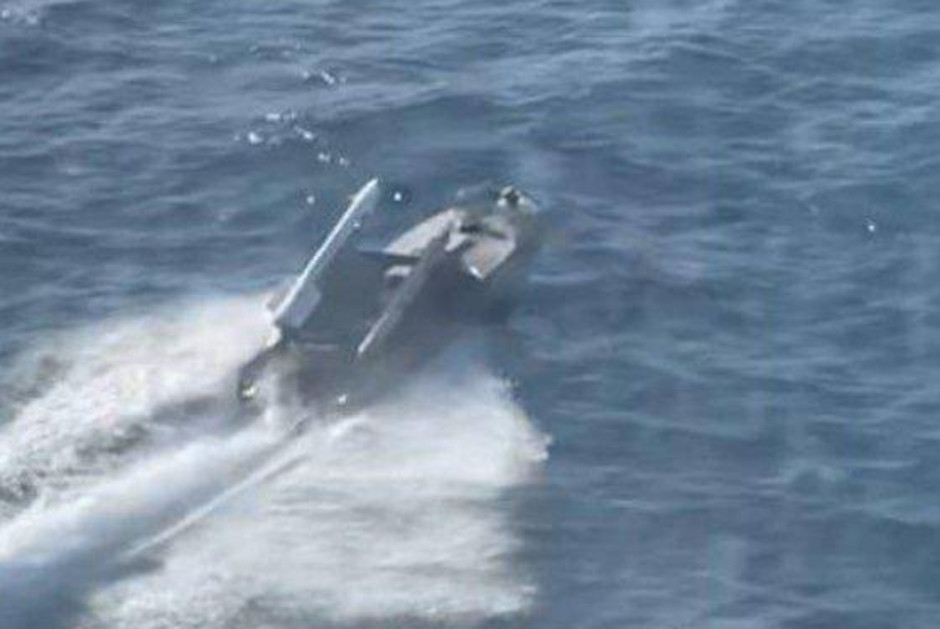
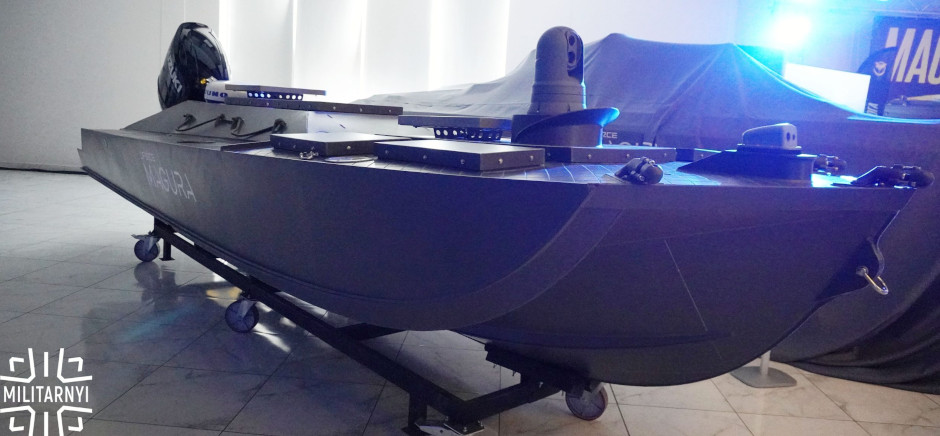
A Magura W6 showing a different configuration with an outboard motor.
Magura V7
 The Magura V7 appears to have partly superseded the Magura V5 in service with the GUR (Ukrainian Defence Intelligence). The type is slightly larger, 7.5 meters long, and can carry two AIM-9L Sidewinder air-air missiles in a ‘FrankenSAM’ configuration. It shares similar lines to the V5 version but has a reshaped bow. This feature suggests improved sea keeping, useful for operations in winter. It has been seen with several communications antenna and sensors.
The Magura V7 appears to have partly superseded the Magura V5 in service with the GUR (Ukrainian Defence Intelligence). The type is slightly larger, 7.5 meters long, and can carry two AIM-9L Sidewinder air-air missiles in a ‘FrankenSAM’ configuration. It shares similar lines to the V5 version but has a reshaped bow. This feature suggests improved sea keeping, useful for operations in winter. It has been seen with several communications antenna and sensors.
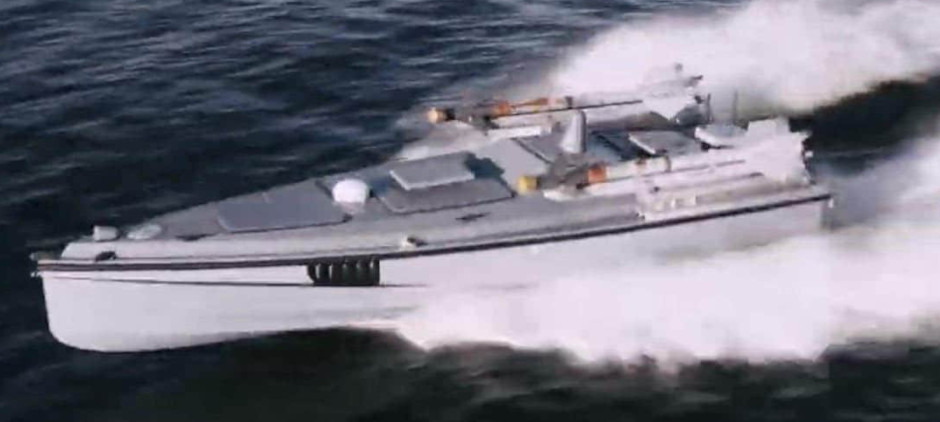
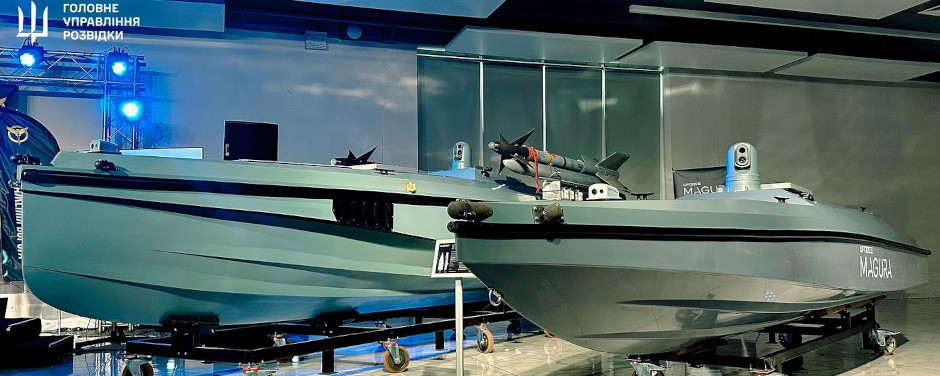
The larger size of the V7 (behind) is apparent compared to the V5 in front.
Toloka TLK-150
 The small Toloka TLK-150 is a natural evolution of Ukraine’s maritime drones which are uncrewed surface vessels (USVs) packed with explosives. Being an underwater vehicle it is less prone to detection and harder to neutralize with gunfire. Its warhead is also impacting below the waterline so may be more likely to sink its target.
The small Toloka TLK-150 is a natural evolution of Ukraine’s maritime drones which are uncrewed surface vessels (USVs) packed with explosives. Being an underwater vehicle it is less prone to detection and harder to neutralize with gunfire. Its warhead is also impacting below the waterline so may be more likely to sink its target.
The design is evidently intended to operate as a form of loitering torpedo. It consists of a typical tubular body, but with a large keel and horizontal stabilizers amidships. Thrusters are mounted on the end of each horizontal stabilizer. Intuitively, these are used for steering as well as propulsion. This should allow significant agility. If the mast is always above water then, technically, you could argue that it’s a semi-submersible. In this case however that distinction may be unhelpful. It’s a weaponized UUV.
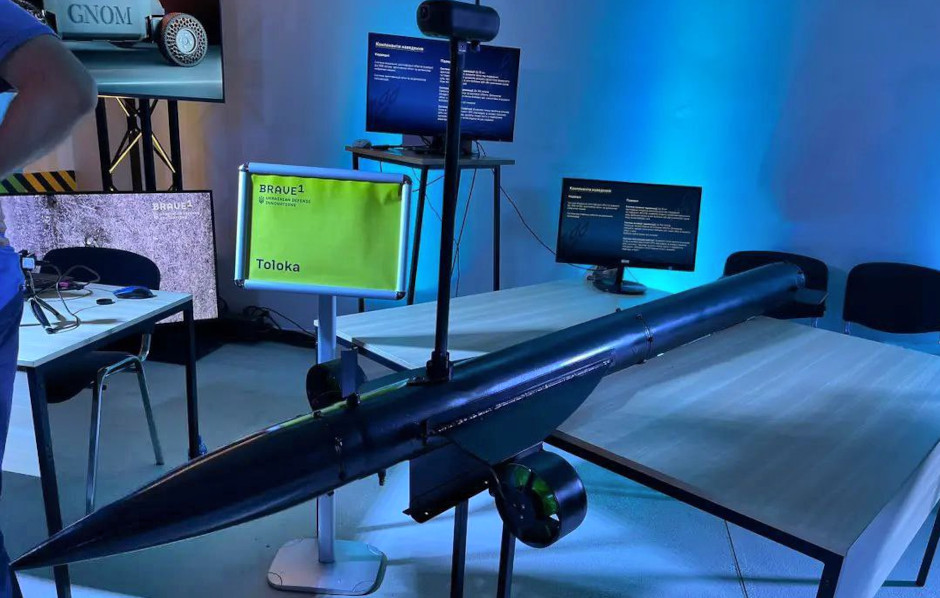
The trade-off will be range and speed. Also, the communications mast, which may contain an electro-optical camera, will need to be above the surface. Although it has been shown publicly, it is unclear whether it is being used operationally. Multiple versions are expected, including one which is 4 meters long and claimed to have a range of 1200 km or 400 km operation radius.
Mamai
 The Mamai was used by Ukraine’s SBU (Security Service of Ukraine) in the attacks on the Ropucha Class landing ship Olenegorsky Gornyak and the tanker Sig. Both attacks, far away from Ukrainian controlled territory, inflicted significant damage.
The Mamai was used by Ukraine’s SBU (Security Service of Ukraine) in the attacks on the Ropucha Class landing ship Olenegorsky Gornyak and the tanker Sig. Both attacks, far away from Ukrainian controlled territory, inflicted significant damage.

It is named after Kozak Mamai (Cossack Mamai/Mamay), a Ukrainian folk hero and one of the standard characters in traditional Ukrainian ‘Vertep’ puppet theater. The design is much larger than the canoe-like USVs (uncrewed surface vessels) first seen in September 2022. And the Magura family of USVs used by GUR (The Main Directorate of Intelligence of the Ministry of Defence of Ukraine). All the same its overall dimensions are still compact. The increased volume likely allows for a large fuel load, giving its demonstrated long range.
The design uses a planing hull which allows a reported top speed of 60 knots (110 kmph). One, sometimes two, satellite communications antenna are fitted, and there is an electro-optical camera-ball. The warhead is detonated by any of three impact sensors protruding at the bow. These have, on this particular model, proven reliable.
Sea Baby
 Ukraine’s SBU operates the Sea Baby USV. This was reportedly used to attack the Kerch bridge on July 17 2023. The design is larger than the Magura types but still overall quite small.
Ukraine’s SBU operates the Sea Baby USV. This was reportedly used to attack the Kerch bridge on July 17 2023. The design is larger than the Magura types but still overall quite small.
CLICK to Enlarge.
Sea Baby Specifications:
Length: 6 meters
Width: 2 meters
Height above the waterline: 0.6 meters
Speed: 49 knots max
Range: 540 nautical miles (1,000 km) with additional fuel tanks.
Payload: 850 kg
Propulsion: 2 x 200hp inboard motors driving twin waterjets.
Communication: Satellite communication.
In addition to the main charge, the Sea Baby can carry RPV-16 thermobaric rockets. Variations of two, four and six small rocket tubes have been seen. The rockets are unguided and have a range of around 1,000 meters. These weapons could serve several purposes. As well as being a primary way to attack a target, they could be used to defend against surface threats. During an attack with a ram-charge, the rockets could be launched to distract or suppress defenses. This latter tactic was used on some Imperial Japanese explosive boats in World War Two.
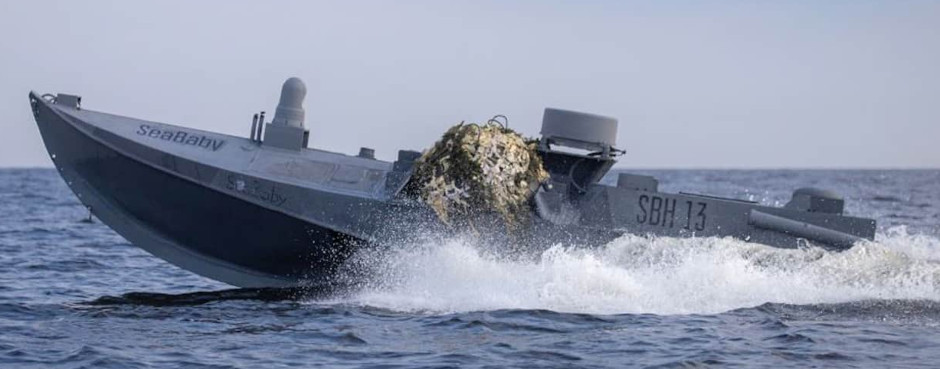
The Sea Baby can be used to launch 6 x 122mm rockets. Several have been modified.

Improved Sea Baby, ‘Avdiivka’
 The improved Sea Baby developed for the SBU was revealed in early March 2024. A single 400 horsepower engine is used in place of the twin jet ski motors of the earlier type. This allows a 400 kg warhead (some reports heavier). It has a range of around 500 nautical miles and a maximum speed in the region of 48 knots. Its reinforced hull can traverse waves 1.5 meters high, while its draft is around 1 meter and height above water 1 meter. Communications includes both a directional Starlink antenna and Kymeta satellite link. Although unconfirmed, it seems likely that like the original Sea Baby it can also carry rockets.
The improved Sea Baby developed for the SBU was revealed in early March 2024. A single 400 horsepower engine is used in place of the twin jet ski motors of the earlier type. This allows a 400 kg warhead (some reports heavier). It has a range of around 500 nautical miles and a maximum speed in the region of 48 knots. Its reinforced hull can traverse waves 1.5 meters high, while its draft is around 1 meter and height above water 1 meter. Communications includes both a directional Starlink antenna and Kymeta satellite link. Although unconfirmed, it seems likely that like the original Sea Baby it can also carry rockets.
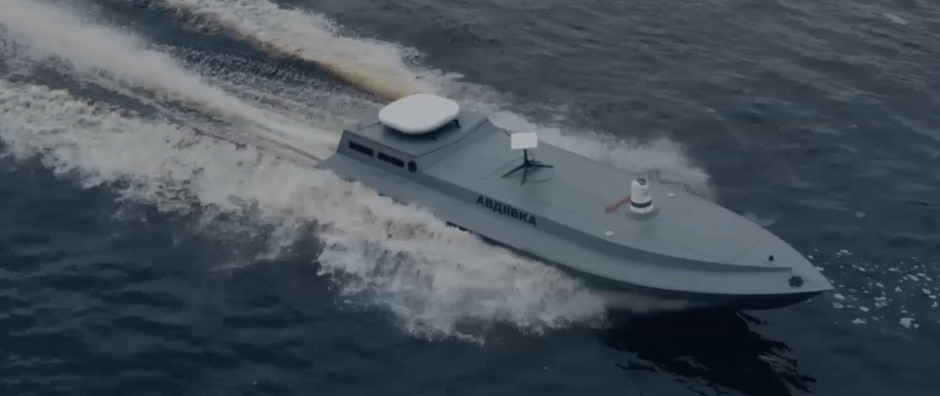
The large white antenna at the stern is Kymeta while the smaller rectangular one is StarLink. Ahead of that is the electro-optical/infrared sensor.
Sea Wolf
Slightly larger than the Sea Baby, the Sea Wolf is offered with a wide range of weapon configurations. Although unconfirmed that it was this type, but it appears that on May 3 2025 an SBU operated Sea Wolf USV shot down a Russian Su-30 FLANKER west of Crimea using an AA-11 ARCHER missile.
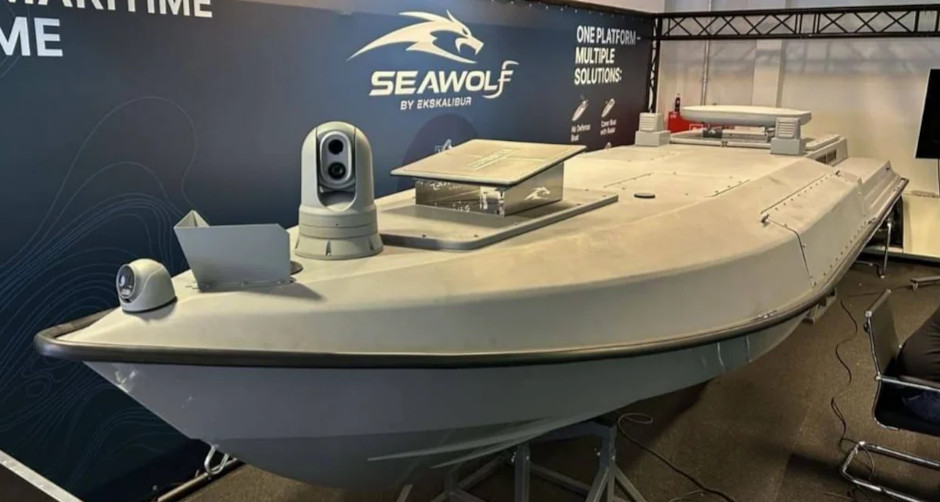
Stalker 5.0
 The Stalker 5.0 USV was revealed at the international Black Sea Security Forum 2024 in Odesa. It is approximately 5 meters long and 1.2 meters wide, and carries a 150kg payload. The vessel uses a 60 hp outboard motor to achieve maximum speeds of 40 knots. Range is 350-600 km. The type is described as being intended for reconnaissance and patrol, and can also be used for transporting supplies. Unit price is stated as 60k USD, making it cheaper than some other designs.
The Stalker 5.0 USV was revealed at the international Black Sea Security Forum 2024 in Odesa. It is approximately 5 meters long and 1.2 meters wide, and carries a 150kg payload. The vessel uses a 60 hp outboard motor to achieve maximum speeds of 40 knots. Range is 350-600 km. The type is described as being intended for reconnaissance and patrol, and can also be used for transporting supplies. Unit price is stated as 60k USD, making it cheaper than some other designs.
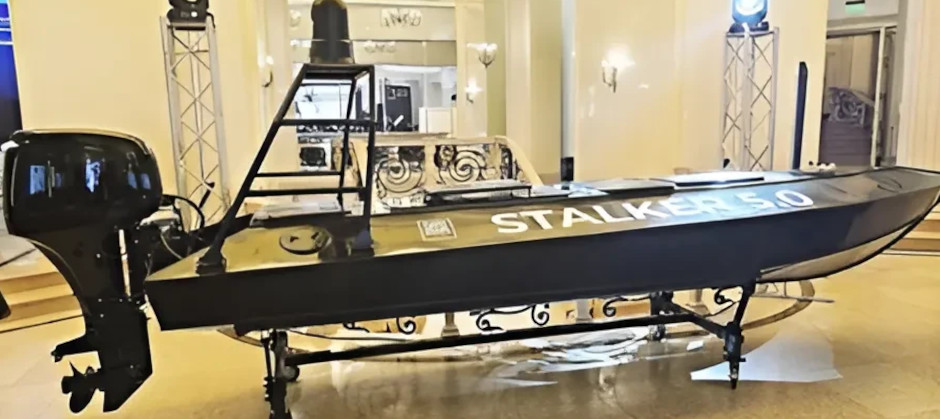
Marichka Underwater Drone (AUV)
 The Marichka (МАРІЧКА) is a new large autonomous underwater vehicle (AUV) developed by AMMO Ukraine. Among the many large AUV projects around the world, it is probably the first born directly from wartime needs. The basic vehicle is 6 meters long and 1 meter in dimeter. Construction is metal with all or most of the hull being a pressure vessel. A keel appears to run along the bottom, and there are the expected towing loops.
The Marichka (МАРІЧКА) is a new large autonomous underwater vehicle (AUV) developed by AMMO Ukraine. Among the many large AUV projects around the world, it is probably the first born directly from wartime needs. The basic vehicle is 6 meters long and 1 meter in dimeter. Construction is metal with all or most of the hull being a pressure vessel. A keel appears to run along the bottom, and there are the expected towing loops.
Ammo Ukraine have advertised the system as being for anti-ship, anti-bridge, intelligence gathering and transport. Range is reportedly 1,000km. Unit cost is stated as 16 million UAH, equivilent to 433k USD.
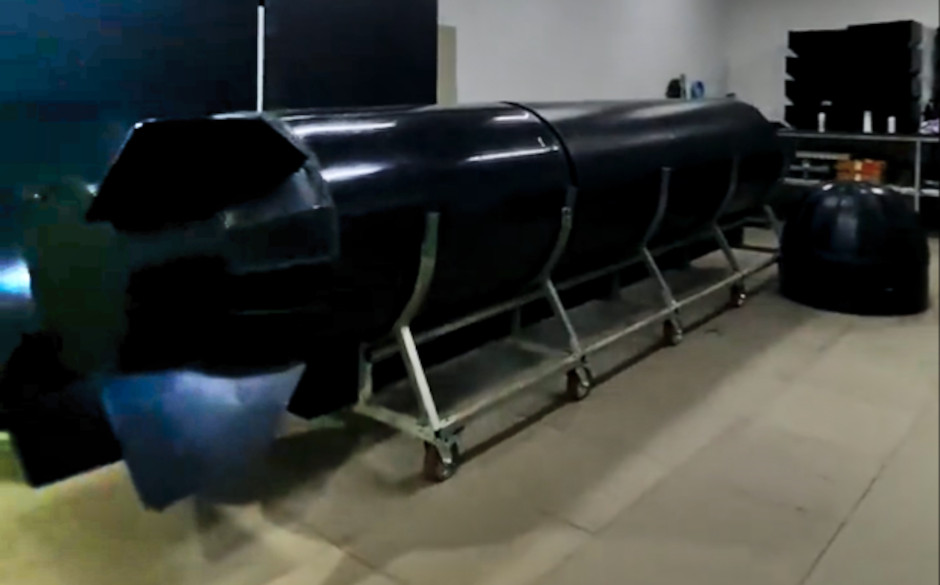
At least one of the prototypes has an X-form rudder configuration. Note the nose cone on the floor at the front of the vehicle.
Weaponized AM-800 RHIB
 An undidentified USV was discovered, float capsized, in Romanian waters on April 3 2024. The craft uses an American-built Silver Ships AM-800 rigid-hull inflatable boat (RHIB) as its base. The warhead was from a STYX anti-ship missile. The vessel has not been formally attributed, but appears most likely Ukrainian.
An undidentified USV was discovered, float capsized, in Romanian waters on April 3 2024. The craft uses an American-built Silver Ships AM-800 rigid-hull inflatable boat (RHIB) as its base. The warhead was from a STYX anti-ship missile. The vessel has not been formally attributed, but appears most likely Ukrainian.
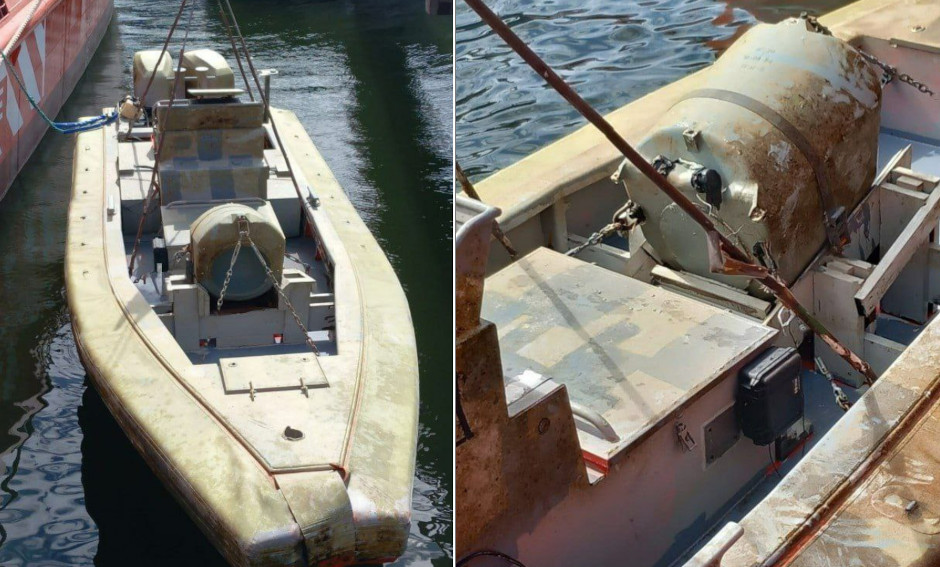
Riverine Resupply USV
 Prototype logistics USV observed with two ammunition containers (US type, 120mm or 155mm rounds). The craft is very small, around 1.5 meters long, and has a 30kg payload.
Prototype logistics USV observed with two ammunition containers (US type, 120mm or 155mm rounds). The craft is very small, around 1.5 meters long, and has a 30kg payload.
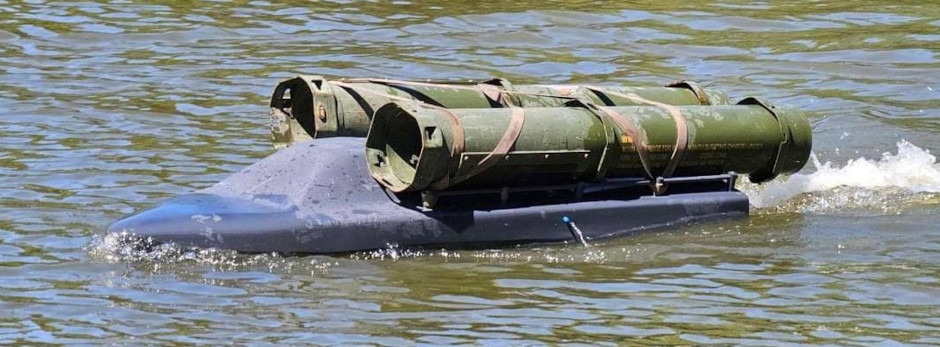
Unnamed Ukrainian Navy USV with FPV Drones
On December 7 2024 the commander of the Ukrainian Navy (VMS ZSU), Vice-Admiral Oleksiy Neizhpapa, shared a video of a new surface drone (USV- uncrewed surface vessel) being used in the Black Sea. The vessel is unique among previously seen types in having a hangar for at least 4 quadrotor FPV drones. It also appears to have a hangar for minelaying over the transom.
CLICK to Enlarge.
Dandelion
 The BBKN Dandelion (ББКН «Одуванчик») is a small USV developed by KMZ (Kingisepp Machine-Building Plant) in St. Petersburg. The latest image suggests a very different design to the RK-700 Vizir USVs previously marketed by the company.
The BBKN Dandelion (ББКН «Одуванчик») is a small USV developed by KMZ (Kingisepp Machine-Building Plant) in St. Petersburg. The latest image suggests a very different design to the RK-700 Vizir USVs previously marketed by the company.

Limited information is available. According to reports it can reach 80 km per hour (43 knots) and has a range of 200 km (108 NM). This would mean that it is shorter ranged than the Ukrainian types. Its payload of 600 kg is similar. Most probably this would be a warhead in the bow, although many options can be considered. However, these specifications are remarkably similar to those published for the RK-700 Vizir design. So a reporting error is a distinct possibility.
Murena 300S
 The Murena 300S appears generally comparable with Ukrainian types. The Murena (Moray Eel) is approximately the same size as the Ukrainian Magura V5 and Sea Navy designs. The producer, LLC KB Center for Unmanned Systems, advertises it for Defense of Naval facilities, mine laying, mine clearance, patrolling and reconnaissance. On September 19 2024 it was displayed to President Putin while armed with UMT 220mm lightweight torpedoes (in dummy form).
The Murena 300S appears generally comparable with Ukrainian types. The Murena (Moray Eel) is approximately the same size as the Ukrainian Magura V5 and Sea Navy designs. The producer, LLC KB Center for Unmanned Systems, advertises it for Defense of Naval facilities, mine laying, mine clearance, patrolling and reconnaissance. On September 19 2024 it was displayed to President Putin while armed with UMT 220mm lightweight torpedoes (in dummy form).
The vessel has a simple metal semi-planing powerboat hull similar to the classic Soviet-era ‘Progress’ series. Unlike most, but not all, Ukrainian designs it has an outboard motor.
CLICK to Enlarge.
Significantly, it appears to have a Starlink antenna. The apparent antenna as been hidden under camouflage netting but its distinctive shape is evident. The corners of the square antenna are also just visible in photographs from the event.
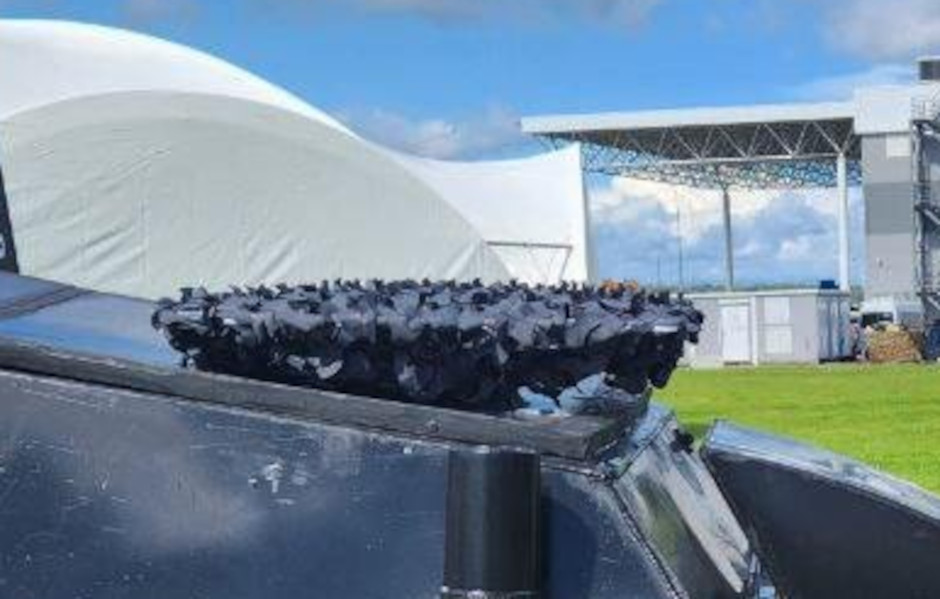
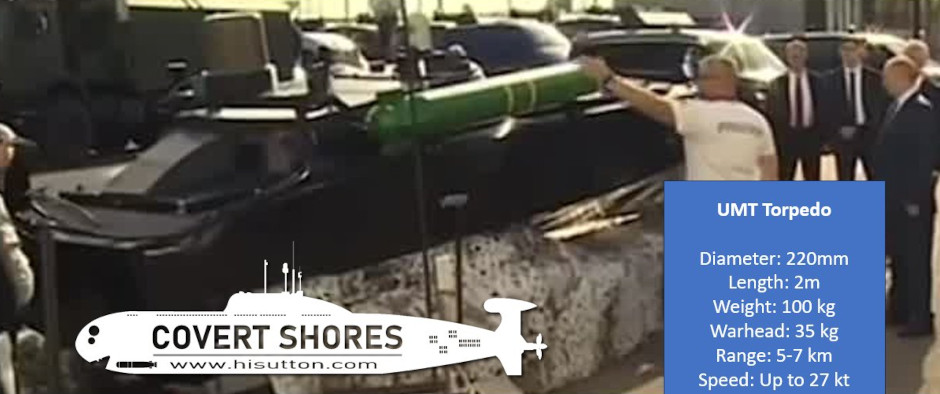
Related articles (Full index of popular Covert Shores articles)

 Ukraine’s Marichka Underwater Drone (AUV)
Ukraine’s Marichka Underwater Drone (AUV)

 Ukraine’s Maritime Drones (USVs)
Ukraine’s Maritime Drones (USVs)

 Nerpa anti-diver UUV
Nerpa anti-diver UUV
 Explosive Boats world history
Explosive Boats world history

 Houthi’s Blowfish: Guide To Explosive USV Threat Off Yemen
Houthi’s Blowfish: Guide To Explosive USV Threat Off Yemen

